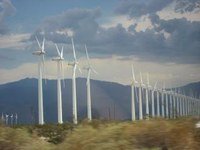Climate change
Long-term changes in temperature and precipitation patterns have a strong influence on the capacity of landscapes to provide ecosystem services to people. Different places will be affected differently, but all of the Appalachian region will continue to experience change.
Water — The impact of climate change on water quality and availability is likely to vary regionally, and outcomes will depend on interactions with human population growth and other factors. Models are sometimes characterized by high uncertainty, but this will be an increasingly crucial issue to understand in the Appalachian region. Average temperature increases may broadly result in reduced water availability, although some areas may be negligibly affected. Rural populations may be more strongly affected than urban populations, due to their stronger reliance on ground water. Frequencies of precipitation extremes potentially associated with flood and drought conditions have increased in recent decades, and this trend is expected to continue. The effects of extreme precipitation events on streamflow can depend strongly on vegetation composition and structure and impervious surface cover. This is true in forested as well as more urbanized and agricultural lands. Low and high flows associated with extreme events may be mitigated, or exacerbated, by forest management practices, urban planning, and other factors.
Timber and nontimber forest products — Habitat suitabilities for harvestable species are likely to show large-scale geographic shifts, and at the local level, expected declines in economically important species will not always be compensated by increases in economically equivalent species. Changes in temperature and precipitation may interact locally with harvest pressure to increase declines, and this risk may be of particular concern for species which are not well monitored or regulated, such as those supporting nontimber forest product markets.
Carbon storage —The impacts of climate change on the capacity of ecosystems to store carbon are likely to vary across landscapes, and interactions with other landscape dynamics will add complexity. For example, rising temperatures can enhance forest growth and carbon storage, but this can be offset by reduced water availability during droughts, and both of these effects depend on which tree species are most common. Changes in the frequency of fire due to temperature and precipitation changes will also modify carbon storage, especially where wildland fire reduces forest cover.
Rural landscape values and outdoor recreation — Long-term changes in temperature and precipitation patterns can have negative impacts on the unique sense of place and quality of life of rural communities, when the viability of different economic activities and the natural character of landscapes are affected. These long-term changes have the potential to re-structure forest ecosystem species compositions, and could, in combination with other stressors, endanger some unique Appalachian ecosystem types. Tourism, recreation, and long-term patterns of rural migration are also likely to be affected by changes in climate, as visitors and new residents seek out particular conditions.
References
Bowker, J. M., and A. Askew. 2013. Outlook for outdoor recreation in the northern United States. A technical document supporting the Northern Forest Futures Project with projections through 2060. Gen. Tech. Rep. NRS-120. USDA Forest Service, Northern Research Station: 62 pp.
Brandt, L., H. He, L. Iverson, F. R. Thompson, III, P. Butler, S. Handler, M. Janowiak, P. D. Shannon, C. Swanston, M. Albrecht, R. Blume-Weaver, P. Deizman, J. DePuy, W. D. Dijak, G. Dinkel, S. Fei, D. T. Jones-Farrand, M. Leahy, S. Matthews, P. Nelson, B. Oberle, J. Perez, M. Peters, A. Prasad, J. E. Schneiderman, J. Shuey, A. B. Smith, C. Studyvin, J. M. Tirpak, J. W. Walk, W. J. Wang, L. Watts, D. Weigel, and S. Westin. 2014. Central Hardwoods ecosystem vulnerability assessment and synthesis: a report from the Central Hardwoods Climate Change Response Framework project. Gen. Tech. Rep. NRS-124, USDA Forest Service, Northern Research Station: 254 pp.
Brzostek, E. R., D. Dragoni, H. P. Schmid, A. F. Rahman, D. Sims, C. A. Wayson, D. J. Johnson, and R. P. Phillips. 2014. Chronic water stress reduces tree growth and the carbon sink of deciduous hardwood forests. Global Change Biology 20(8): 2531-2539.
Butler, P., L. Iverson, F. R. Thompson, III, L. Brandt, S. Handler, M. Janowiak, P. D. Shannon, C. Swanston, K. Karriker, J. Bartig, S. Connolly, W. D. Dijak, S. Bearer, S. Blatt, A. Brandon, E. Byers, C. Coon, T. Culbreth, J. Daly, W. Dorsey, D. Ede, C. Euler, N. Gillies, D. M. Hix, C. Johnson, L. Lyte, S. Matthews, D. McCarthy, D. Minney, D. Murphy, C. O'Dea, R. Orwan, M. Peters, A. Prasad, C. Randall, J. Reed, C. Sandeno, T. Schuler, L. Sneddon, B. Stanley, A. Steele, S. Stout, R. Swaty, J. Teets, T. Tomon, J. Vanderhorst, J. Whatley, and N. Zegre. 2014. Central Appalachians ecosystem vulnerability assessment and synthesis: a report from the Central Appalachians Climate Change Response Framework. Gen. Tech. Rep. NRS-124,USDA Forest Service, Northern Research Station: 310 pp.
Cordell, H. K., C. J. Betz, S. H. Mou, and D. D. Gormanson. 2012. Outdoor recreation in the Northern United States. Gen. Tech. Rep. NRS-100. USDA Forest Service, Northern Research Station: 74 pp.
Cordell, H. K., V. Heboyan, F. Santos, and J. C. Bergstrom. 2011. Natural amenities and rural population migration: a technical document supporting the Forest Service 2010 RPA Assessment. Gen. Tech. Rep. SRS-146. USDA Forest Service, Southern Research Station: 23 pp.
Dale, V. H., L. A. Joyce, S. McNulty, R. P. Neilson, M. P. Ayres, M. D. Flannigan, P. J. Hanson, L. C. Irland, A. E. Lugo, C. J. Peterson, D. Simberloff, F. J. Swanson, B. J. Stocks, and B. M. Wotton. 2001. Climate change and forest disturbances: Climate change can affect forests by altering the frequency, intensity, duration, and timing of fire, drought, introduced species, insect and pathogen outbreaks, hurricanes, windstorms, ice storms, or landslides. BioScience 51(9): 723-734.
Ford, C. R., S. H. Laseter, W. T. Swank, and J. M. Vose. 2011. Can forest management be used to sustain water-based ecosystem services in the face of climate change? Ecological Applications 21(6): 2049-2067.
Hwang, T., L. E. Band, C. F. Miniat, C. Song, P. V. Bolstad, J. M. Vose, and J. P. Love. 2014. Divergent phenological response to hydroclimate variability in forested mountain watersheds. Global Change Biology 20(8): 2580-2595.
Iverson, L. R., A. M. Prasad, S. N. Matthews, and M. Peters. 2008. Estimating potential habitat for 134 eastern US tree species under six climate scenarios. Forest Ecology and Management 254(3): 390-406.
Jackson, L. E., B. Rashleigh, and M. E. McDonald. 2012. Economic value of stream degradation across the central Appalachians. Journal of Regional Analysis and Policy 42(3): 188-197.
Keyser, T., J. Malone, C. Cotton, and J. Lewis. 2014. Outlook for Appalachian-Cumberland forests: a subregional report from the Southern Forest Futures Project. General Technical Report SRS-GTR-188. USDA Forest Service, Southern Research Station: 83 pp.
Lal, P., J. R. R. Alavalapati, and E. Mercer. 2011. Socio-economic impacts of climate change on rural United States. Mitigation and Adaptation Strategies for Global Change 16(7): 819-844.
Lockaby, G., C. Nagy, J. M. Vose, C. R. Ford, G. Sun, S. McNulty, P. Caldwell, E. Cohen, and J. Moore Myers. 2013. Forests and water, Chapter 13, 309-339. In D. N. Wear and J. G. Greis, editors, The Southern Forest Futures Project: Technical Report. Gen. Tech. Rep. SRS-178, USDA Forest Service, Southern Research Station: 542 pp.
Matthews, S. N., L. R. Iverson, M. P. Peters, A. M. Prasad, and S. Subburayalu. 2014. Assessing and comparing risk to climate changes among forested locations: Implications for ecosystem services. Landscape Ecology 29(2): 213-228.
Prasad, A. M., J. D. Gardiner, L. R. Iverson, S. N. Matthews, and M. Peters. 2013. Exploring tree species colonization potentials using a spatially explicit simulation model: Implications for four oaks under climate change. Global Change Biology 19(7): 2196-2208.
Souther, S., and J. B. McGraw. 2014. Synergistic effects of climate change and harvest on extinction risk of American ginseng. Ecological Applications 24(6): 1463-1477.
U.S. Department of Agriculture Forest Service. 2012. Future of America's Forests and Rangelands: Forest Service 2010 Resources Planning Act Assessment. Gen. Tech. Rep. WO-87. USDA Forest Service: 198 pp.
Wear, D. N., R. Huggett, R. Li, B. Perryman, and S. Liu. 2013. Forecasts of forest conditions in regions of the United States under future scenarios: a technical document supporting the Forest Service 2012 RPA Assessment. Gen. Tech. Rep. SRS-GTR-170. USDA Forest Service, Southern Research Station: 101 pp.
Zolkos, S. G., P. Jantz, T. Cormier, L. R. Iverson, D. W. McKenney, and S. J. Goetz. 2015. Projected tree species redistribution under climate change: Implications for ecosystem vulnerability across protected areas in the Eastern United States. Ecosystems 18(2): 202-220.



![Hemlock Wooly Adelgid By Nicholas A. Tonelli from Pennsylvania, USA (Henry's Woods (6)) [CC BY 2.0 (http://creativecommons.org/licenses/by/2.0)], via Wikimedia Commons](https://landscapepartnership.org/ecosystem-risks-benefits/risks/hemlock-wooly-adelgid/@@images/b0bf0bc4-1b53-4b20-8e38-e82d344bee8c.jpeg)

![Wildfires in Eastern U.S. By Glenn Research Center (https://www.dvidshub.net/image/857727) [Public domain], via Wikimedia Commons](https://landscapepartnership.org/ecosystem-risks-benefits/risks/wildfires-in-eastern-u.s/@@images/0d2bbb65-9ef4-4070-a99f-c36b403f71cf.jpeg)
























